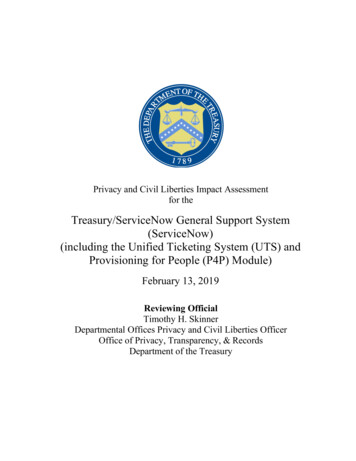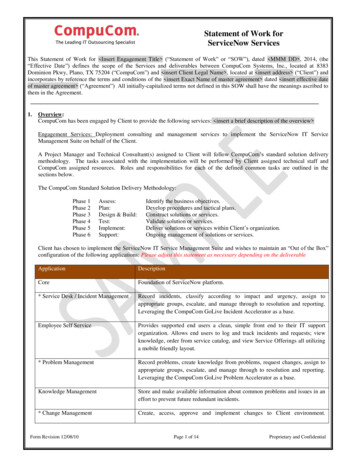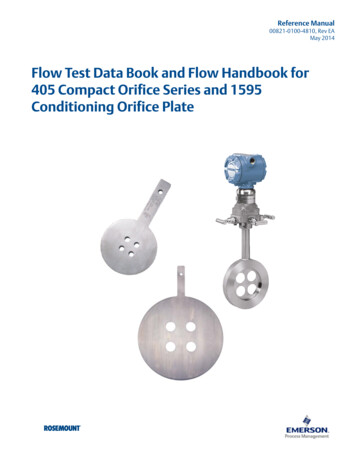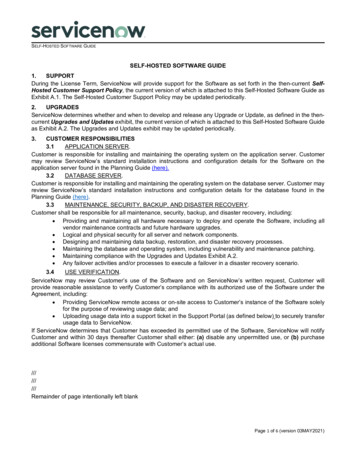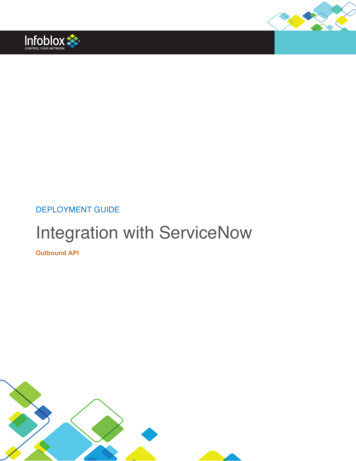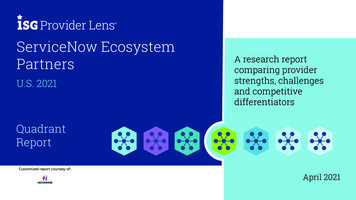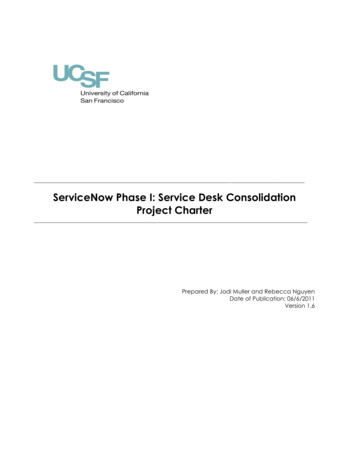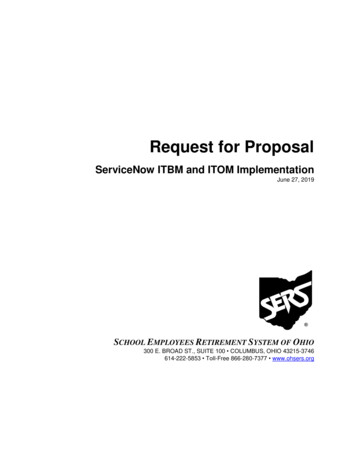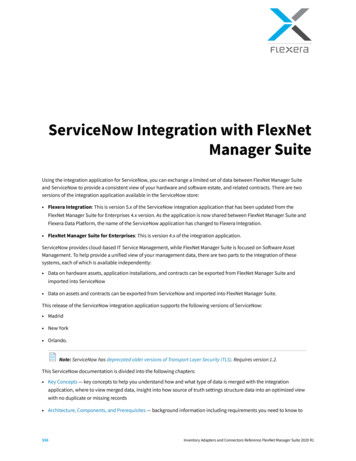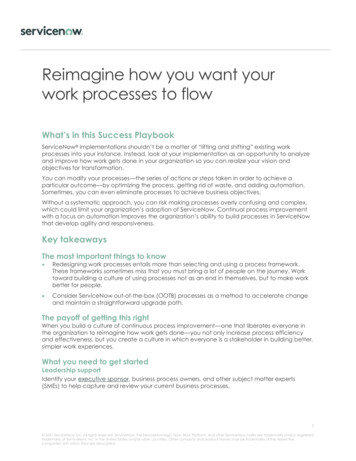
Transcription
Reimagine how you want yourwork processes to flowWhat’s in this Success PlaybookServiceNow implementations shouldn’t be a matter of “lifting and shifting” existing workprocesses into your instance. Instead, look at your implementation as an opportunity to analyzeand improve how work gets done in your organization so you can realize your vision andobjectives for transformation.You can modify your processes—the series of actions or steps taken in order to achieve aparticular outcome—by optimizing the process, getting rid of waste, and adding automation.Sometimes, you can even eliminate processes to achieve business objectives.Without a systematic approach, you can risk making processes overly confusing and complex,which could limit your organization’s adoption of ServiceNow. Continual process improvementwith a focus on automation improves the organization’s ability to build processes in ServiceNowthat develop agility and responsiveness.Key takeawaysThe most important things to know Redesigning work processes entails more than selecting and using a process framework.These frameworks sometimes miss that you must bring a lot of people on the journey. Worktoward building a culture of using processes not as an end in themselves, but to make workbetter for people. Consider ServiceNow out-of-the-box (OOTB) processes as a method to accelerate changeand maintain a straightforward upgrade path.The payoff of getting this rightWhen you build a culture of continuous process improvement—one that liberates everyone inthe organization to reimagine how work gets done—you not only increase process efficiencyand effectiveness, but you create a culture in which everyone is a stakeholder in building better,simpler work experiences.What you need to get startedLeadership supportIdentify your executive sponsor, business process owners, and other subject matter experts(SMEs) to help capture and review your current business processes.1 2021 ServiceNow, Inc. All rights reserved. ServiceNow, the ServiceNow logo, Now, Now Platform, and other ServiceNow marks are trademarks and/or registeredtrademarks of ServiceNow, Inc. in the United States and/or other countries. Other company and product names may be trademarks of the respectivecompanies with which they are associated.
StakeholdersIdentify key process users who actually engage with the processes to ensure that you have afirst-hand account of what’s working and what could be improved.When you should start this activity Start reviewing your business processes when you begin evaluating ServiceNow as yoursolution of choice. While you’re capturing requirements for your initial implementation, startthinking about how you can use standard ServiceNow processes that support your businessneeds. Before you start process redesign, establish roles for governance, especially for yourexecutive steering board.2 2021 ServiceNow, Inc. All rights reserved. ServiceNow, the ServiceNow logo, Now, Now Platform, and other ServiceNow marks are trademarks and/or registeredtrademarks of ServiceNow, Inc. in the United States and/or other countries. Other company and product names may be trademarks of the respectivecompanies with which they are associated.
Playbook overviewServiceNow recommends completing the six steps listed in this table to reimagine yourServiceNow processes.If you haven’t documented and reviewed your business processes with your stakeholders, startwith Step 1.If you currently have a process improvement practice in place, you may want to start with Steps4 and 5 to improve how you’re evolving your ServiceNow work processes.3 2021 ServiceNow, Inc. All rights reserved. ServiceNow, the ServiceNow logo, Now, Now Platform, and other ServiceNow marks are trademarks and/or registeredtrademarks of ServiceNow, Inc. in the United States and/or other countries. Other company and product names may be trademarks of the respectivecompanies with which they are associated.
Step 1 – Assess your existing processesKEY INSIGHTS You can’t overestimate the importance of first-hand experience in documenting currentprocesses. The point is not to create the perfect as-is document—it’s to get all parties in the same roomto get consensus on what’s currently happening. Certification in frameworks like ITIL and Six Sigma shouldn’t be the sole criterion for identifyingprocess owners. The best process owners are skilled in influence and collaboration, so theycan promote (rather than police) a companywide culture of process improvement.Before you deploy processes in ServiceNow, take time to document and review your currentprocesses—the roles, steps, and interactions with other processes—that support your desiredbusiness outcomes. As part of this, define ownership and oversight to make sure yourorganization follows and adopts the processes, and that the processes are optimized andcontinually improved so you can realize business value.If processes haven’t been formally documented at your organization, it’s worth investing inprocess mapping before you deploy processes in ServiceNow. The exercise of meeting anddiscussing processes can be as valuable as building process maps, because it bringsstakeholders together to understand how work is currently performed. Start by mapping onlythose processes that will be implemented during your initial ServiceNow deployment.To assess your existing processes, you need to take six action steps:1. Ensure clear ownership for core processes.Assign process owners—the people responsible for the definition and oversight of aprocess—for processes managed in ServiceNow. Process owners should not only be SMEs intheir assigned processes, but they should positively influence, communicate, andcollaborate with delivery teams2. Define process ownership responsibilities and authorities.Define the scope of the process owner’s responsibilities, which includes:–Process development, documentation, and improvement–Ensuring resources are in place to support process delivery–Process team training–Coordination with other process owners to align goals and objectives–Understanding the business objectives of the processes they manageYou’ll also need to identify where process owner responsibilities overlap with existing rolesand verify that these overlaps won’t cause confusion.4 2021 ServiceNow, Inc. All rights reserved. ServiceNow, the ServiceNow logo, Now, Now Platform, and other ServiceNow marks are trademarks and/or registeredtrademarks of ServiceNow, Inc. in the United States and/or other countries. Other company and product names may be trademarks of the respectivecompanies with which they are associated.
3. Communicate the process owner responsibilities to senior leaders to build support forprocess improvement goals.Meet with senior executives to educate them on the importance of process ownership andto gain their support. Schedule monthly one-on-one meetings between process owners andthe appropriate senior executives within their function so they can vet their processimprovement ideas and earn leadership support. Include process owners in all major reviewand budget meetings associated with their assigned processes—and if they aren’t already,process discussions should be a regular part of senior leadership meetings.4. Map how specific processes chain together to support the business outcome you want tosupport with ServiceNow.No process should be considered a standalone. Before you build process maps, start withthe vision of your ServiceNow implementation and define end-to-end processes—calledvalue streams—that contribute to those outcomes. Don’t forget to include processes thatsupport planning, building, transitioning, delivering, and supporting those outcomes. Figure 1shows an example.Figure 1: Value stream mapping for IT5. Work with process owner(s) to build as-is process maps.After you visualize your value stream, document the end-to-end process you plan toimplement in ServiceNow as it currently exists and note the outcome you expect to see atthe end of the process. Make sure you include any process inputs, outputs, and intersectionpoints with other existing processes. Then, list all the roles involved in the process and recordany handoffs between both roles and systems involved. Use visual diagrams to depict howthe process works as well as to gain consensus during process documentation meetings.5 2021 ServiceNow, Inc. All rights reserved. ServiceNow, the ServiceNow logo, Now, Now Platform, and other ServiceNow marks are trademarks and/or registeredtrademarks of ServiceNow, Inc. in the United States and/or other countries. Other company and product names may be trademarks of the respectivecompanies with which they are associated.
6. Run a process review exercise with process owners and the teams responsible for eachprocess to define where value is increased or lost in your as-is state.Hold workshops with your process owners to define how teams currently understand andpractice the process, including the known issues, potential redundancies, and definitions ofterms. Look for ways to consolidate and streamline handoffs between teams, individuals,and systems to remove unnecessary bottlenecks. Looks for instances when data is collectedbut is either never used or isn’t needed for the process to work. Document which processsteps have consistently long cycle times and the reasons for them. To maintain processquality, look for steps that don’t consistently adhere to standards.EXPERT TIPAs you define process ownership, ask yourself three questions: Does my organization follow a process framework of any kind (like ITIL)? If yes, how aware and/or educated is the broader organization about the processes inthis framework? If awareness and/or education is low, do I need to provide some sort of baselineeducation before I can meaningfully assign process ownership?Customer insightsCustomer experience points to two insights you should keep in mind as you assess your existingprocesses.INSIGHT 1:Consensus matters more than documentationOrganizations can become paralyzed in the pursuit of creating the perfect depiction of the as-isprocess. While accuracy is important, consensus among stakeholders—process owners,requesters, fulfillers, and consumers—is a more valuable outcome of the mapping process.Losing sight of this insight can lead to low-value discussions about semantics, exceptions thatdon’t materially affect the outcome, and delays that eat away at potential time savings later.When people get in a conference room and discuss a process, they’re limited by the inevitableabstractions and inconsistencies that arise. They might overlook important physical requirements,or they may not truly understand the scope of a process. In short, being disconnected from theprocess inhibits the design team’s ability to empathize with the process stakeholders, which canshort-change the process improvement design.Best practice – Agree to stop the baseline review process once you reach consensusTo avoid an overly long baseline review, obtain consensus that you’ve adequately captured theas-is process. Gather existing process documentation – Even if this documentation is outdated, it canprovide context on how the current process evolved over time.6 2021 ServiceNow, Inc. All rights reserved. ServiceNow, the ServiceNow logo, Now, Now Platform, and other ServiceNow marks are trademarks and/or registeredtrademarks of ServiceNow, Inc. in the United States and/or other countries. Other company and product names may be trademarks of the respectivecompanies with which they are associated.
Conduct interviews with stakeholders – This is a great opportunity to get all stakeholders (atleast one per role) together in a room and have an active discussion of the current stepsand handoffs. Document and map the process – You should include all:–Process inputs–Steps from when the process starts to where it ends–Expected outcomes from the process–Roles involved in the process–Handoffs between roles, systems, and other processes–Performance metrics used to assess performance Conduct a baseline process review workshop – The purpose of the workshop is to gainconsensus that the process has been captured accurately. This is the time to identifyinconsistencies or gaps in how different teams or team members understand the process.This step is critical not only to avoid unnecessarily long review cycles, but also to ensure thatpotential improvements are based on an agreed-to process map. Request sign-off fromstakeholders that the process map accurately reflects the current process. Conduct a process analysis workshop – Conduct a second workshop to review theapproved process maps, looking for redundancy, waste, or gaps. Answer these questions:–Where can we consolidate and streamline handoffs between teams, individuals, andsystems?o–Where are we collecting unnecessary data?o–Identify where forms and requirements collect data that isn’t used or needed for theprocess to work.Where are we seeing the longest cycle times? Why?o–Review handoffs to identify points where handoffs are creating unnecessarybottlenecks in existing process.Identify process steps with consistently long cycles times and diagnose why.Where do we have gaps in standards adherence?oDocument process steps that don’t consistently adhere to standards.The answers to these questions will form the basis for the specific improvement opportunities thatyou’ll develop in Step 2.Best Practice – Perform a formal design walk for each process you’re looking to redesignYour process owners and stakeholders should consider a Gemba walk, or formal design walk, togain valuable insights into the process you’re designing at the place the work is done. It’s acollaborative approach that offers employees the chance to provide details about what theydo and why during a process.The Gemba walk can be done either to gather as-is process information or during the designphase to flesh out requirements.7 2021 ServiceNow, Inc. All rights reserved. ServiceNow, the ServiceNow logo, Now, Now Platform, and other ServiceNow marks are trademarks and/or registeredtrademarks of ServiceNow, Inc. in the United States and/or other countries. Other company and product names may be trademarks of the respectivecompanies with which they are associated.
The key steps of a Gemba walk are: Prepare the team – Talk about the walk ahead of time with team members to setexpectations. Have a plan – Have a list of questions prepared that focus on the actions, roles, timing, anddependencies of the process. Follow the value stream – Look for transitions between departments, processes, or people. Always focus on the process, not people – This shouldn’t be an employee evaluation. Document your observations – Write down observations in real time. You can even useServiceNow Continual Improvement Management. Ask questions – Who? What? Where? When? Why? How long? Don’t suggest changes during the walk – Keep the focus on observation, not action. Walk in teams – While not necessary, consider bringing a leader from another area for afresh point of view. Mix up the schedule – Different times of day might reveal different design considerations. Follow up with employees – Always have a review of the observations made during the walk. Return to the Gemba – If you make changes, take another walk to observe them in action.INSIGHT 2:Make sure your process owners understand the strategy and can navigate theorganizationDon’t make certification in frameworks like ITIL and Six Sigma the sole criterion for identifyingpotential process owners. These certifications are certainly beneficial when it comes tomanaging the review and documentation activities, but they’re not the only skill set required.“Formal attempts to explain [process management] result in glazed eyes. So, it’s difficult just toget process management as a concept to be understood by the people that need toparticipate in the process.”– A ServiceNow customerThe best process owners are skilled in influence, collaboration, and organizational navigation sothey can promote a companywide culture of process improvement and not just police orinform. Process owners need to be adept at navigating their organizations to identifystakeholders and get them involved in process improvement.Best practice – Build clarity between your as-is processes and your strategic business objectivesfor ServiceNowExecutive sponsorship is key to successful process improvement. Process owners should be wellversed in your desired business objectives for the ServiceNow program, and they should be ableto connect those objectives to gaps or issues revealed by your as-is process mapping. When8 2021 ServiceNow, Inc. All rights reserved. ServiceNow, the ServiceNow logo, Now, Now Platform, and other ServiceNow marks are trademarks and/or registeredtrademarks of ServiceNow, Inc. in the United States and/or other countries. Other company and product names may be trademarks of the respectivecompanies with which they are associated.
capturing as-is processes, process owners need to build a clear, unified point of view andconsensus on how your current state is impeding your ability to realize business objectives.What to do nextNow that you’ve captured as-is processes and you have clear ownership, make sure you spreadthe word about the importance of process ownership and frameworks throughout yourorganization. Emphasize that process ownership isn’t only about efficiency—it’s critical tomeeting business objectives and achieving value.Revisit process ownership periodically, especially as you expand ServiceNow into new processareas. For example, you might need to look for any overlaps or gaps that occur if you’reimplementing a new shared services organization. Update your documentation of the roles andresponsibilities (for example, through a RACI chart) if any changes are required.9 2021 ServiceNow, Inc. All rights reserved. ServiceNow, the ServiceNow logo, Now, Now Platform, and other ServiceNow marks are trademarks and/or registeredtrademarks of ServiceNow, Inc. in the United States and/or other countries. Other company and product names may be trademarks of the respectivecompanies with which they are associated.
Step 2 – Identify process improvement opportunitiesKEY INSIGHTS When creating to-be processes, consider how they align with business objectives,dependencies with other processes, and adoption. Even if OOTB ServiceNow processes aren’t a 100% match to your desired to-be processes,you may get to your next level of maturity faster by going OOTB.When you’ve documented which processes contribute to delivering your ServiceNow objectivesand mapped how they currently work, it’s time to map how you want these processes to work inServiceNow. After that, you can assemble a wish list of process improvement opportunities toimplement, starting with quick wins that resolve immediate pain points.It’s a good idea to define to-be process maps even if you intend to implement OOTBServiceNow processes (as we recommend). This mapping exercise provides an opportunity foryour team to understand why changes are being made to existing processes as you move toServiceNow, which will help them accept any new OOTB ServiceNow processes that you chooseto implement.To identify process improvement opportunities, you need to take three action steps:1. Work with process owner(s) to build to-be process maps that document how you want workto flow after implementing ServiceNow.Keeping your desired outcomes from Step 1 in mind, create new to-be process maps thatdepict how you would ideally want work to flow through the process, including details on:–How you should redefine the process steps–How and where you should modify or eliminate handoffs–Which steps you need to improve (like making it faster, more reliable, easier to navigate,etc.), and how (automation, step removal, improved forms, etc.)–How you should fix as-is process standards and adherence gaps2. Comp
process mapping before you deploy processes in ServiceNow. The exercise of meeting and discussing processes can be as valuable as building process maps, because it brings stakeholders together to understand how work is currently performed. Start by mapping only those processes that will
